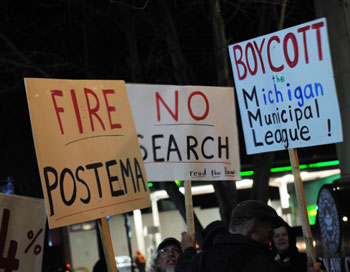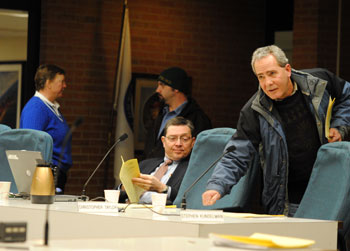Medical Marijuana Plan Amended, Delayed
Ann Arbor City Council meeting (Jan. 3, 2011): The council’s meeting was held in the Washtenaw County board of commissioners boardroom to accommodate current renovations to city hall. Before the meeting, advocates for medical marijuana demonstrated with signs and chants on the sidewalk outside the Washtenaw County administration building on North Main.

Signs held by advocates for medical marijuana before the start of the Jan. 3 Ann Arbor city council meeting. Stephen Postema is the city attorney for Ann Arbor, and also president of the Michigan Association of Municipal Attorneys, a section of the Michigan Municipal League. Postema has pushed for a licensing scheme that some medical marijuana advocates say violates the state statute. (Photos by the writer.)
Inside at the meeting, the council ultimately delayed their vote on an initial approval of a licensing scheme for medical marijuana dispensaries, cultivation facilities and home occupations. That initial vote is now scheduled for Jan. 18, with final approval expected in early February, along with zoning regulations affecting medical marijuana-related businesses. The licensing proposal to be considered by the council at its next meeting will be significantly different from the one that they started with Monday night, due to various amendments councilmembers approved, before voting to postpone the measure.
Amendments included: eliminating home occupations from the licensing scheme; increasing the number of licenses to 20 for dispensaries and 10 for cultivation facilities; creating a licensing board; removing reference to “misdemeanor involving a controlled substance”; and revising the language of required internal signage.
The council also dispatched with several other pieces of major business, with scant deliberation. Those included: final approval of revisions to the city’s area, height and placement regulations in the zoning code; final approval for adoption of the Michigan Vehicle Code and the Uniform Traffic Code; appropriation of funds for footing drain disconnection; approval of new fire inspection fees; and a contract for weapons screening services at the new municipal center. [Full Story]





